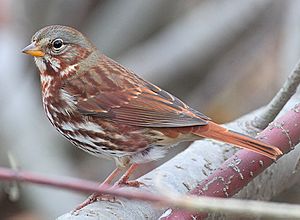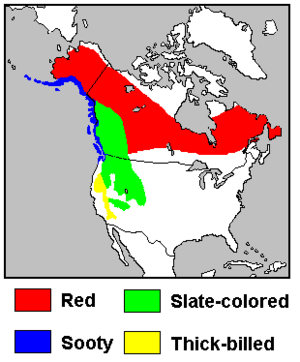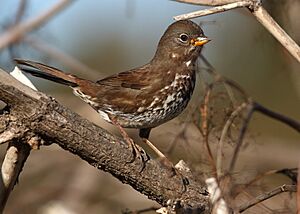Fox sparrow facts for kids
Quick facts for kids Fox sparrow |
|
|---|---|
 |
|
| Red fox sparrow (P. i. iliaca), Whitby, Ontario | |
| Conservation status | |
| Scientific classification | |
| Genus: |
Passerella
|
| Species: |
iliaca
|
 |
|
| Breeding ranges of the four fox sparrow groups | |
The fox sparrow (Passerella iliaca) is a large New World sparrow. It's the only bird in its group, called Passerella. However, some scientists think there might actually be four different types of fox sparrows, not just one!
Contents
Types of Fox Sparrows
Scientists have identified four main groups of fox sparrows. Each group has slightly different colors and lives in different areas.
- Red Fox Sparrow (P. i. iliaca): These sparrows breed in the northern forests of Canada and Alaska. They spend their winters in central and eastern North America. This group is the brightest in color.
- Sooty Fox Sparrow (P. i. unalaschcensis): You can find these sparrows along the Pacific coast of North America. They live from the Aleutian Islands down to Washington. In winter, they fly south to northern Baja California. They are browner and darker than the red fox sparrow.
- Slate-colored Fox Sparrow (P. i. schistacea): This group breeds in the western parts of North America. They spend their winters further south and west. They have a gray head, gray back, brown wings, and a reddish-brown tail. Their chest has brown streaks.
- Thick-billed Fox Sparrow (P. i. megarhyncha): These sparrows mostly live in California and Oregon. They look similar to the slate-colored fox sparrow. As their name suggests, they have a noticeably thicker bill.
Appearance of the Fox Sparrow
Adult fox sparrows are among the largest sparrows you can find. They have many spots and streaks on their underside. All of them have a messy spot in the middle of their chest. This spot is less easy to see on the thick-billed and slate-colored types. The colors of their feathers change a lot between the different groups.
Measurements
- Length: Fox sparrows are usually between 5.9 and 7.5 inches (15-19 cm) long.
- Weight: They weigh about 0.9 to 1.6 ounces (26-44 grams).
- Wingspan: Their wings can spread out to about 10.5 to 11.4 inches (26.7-29 cm) wide.
Behavior
These birds look for food by scratching the ground. This way of finding food can make them easy targets for predators like cats. However, they are generally quite common birds. Fox sparrows that live on the west coast of the United States migrate to different areas during the year.
Diet
Fox sparrows mainly eat seeds and insects. They also enjoy eating some berries. If they live near the coast, they might even eat small crustaceans.
Reproduction
Fox sparrows build their nests in wooded areas. You can find them across northern Canada and western North America, from Alaska to California. They build their nests either in a hidden spot on the ground or low down in trees or bushes. A typical nest holds two to five eggs. These eggs are usually pale green or greenish-white with reddish-brown speckles.
How Scientists Study Fox Sparrows
Scientists have studied the fox sparrow using DNA. They looked at the DNA to understand how the different groups are related. These studies have shown that the four main groups of fox sparrows are quite distinct from each other.
Some scientists believe these four groups should be considered separate species. Other scientists think they are still just different types of the same species. Major bird organizations around the world have different opinions on this. Some lists treat them as four separate species, while others still consider them one single species.
See also
 In Spanish: Chingolo zorruno para niños
In Spanish: Chingolo zorruno para niños



